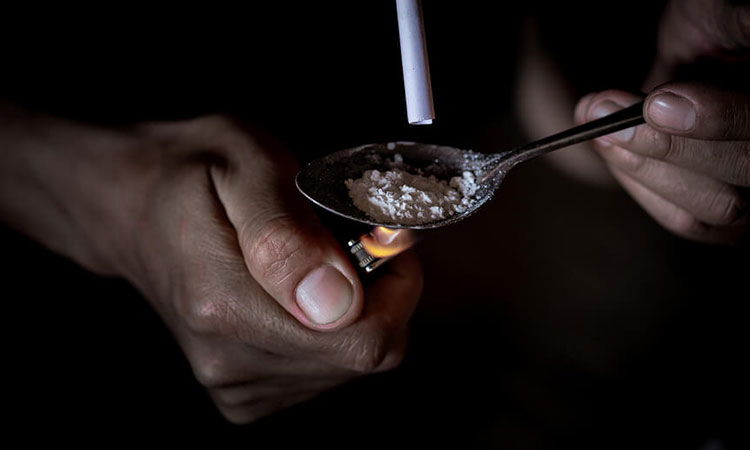
Smoking heroin is extremely hazardous, and the notion that it is safer than other methods of consumption is a dangerous myth. Heroin is a semi-synthetic opioid derived from the opium alkaloid morphine, a narcotic that is commonly used to treat pain. Heroin is usually found in powder form in colors ranging from white to brown and also as a dark tacky substance, aptly referred to as black tar heroin.
Heroin is abused for the “rush” that occurs soon after use. This intense feeling of pleasure tends to lead to additional use, as the person attempts to replicate the initial experience. After heroin reaches the brain, it is converted back into morphine and thus produces a comparable effect.
Heroin can be administered in a variety of ways, the most common methods being smoking, snorting, and through intravenous injection. To smoke heroin, users burn it then inhale the smoke into the lungs, usually through a makeshift tube or straw.
Some people erroneously believe that smoking or snorting heroin is not as dangerous or addictive as injecting it. Unfortunately, heroin is very addictive no matter the method of administration, and it can have severe effects on the body, in both the short- and the long-term.
Effects of Smoking Heroin on the Body
The initial rush is what usually drives most people to continue using heroin. This surge of euphoric feeling is often accompanied by a sensation of warmth and a heavy feeling in the limbs. Heroin tends to make users feel as if things around them have slowed down, and they often feel sleepy as a result.
These short-term effects are often experienced about 10-15 minutes after smoking heroin. Following the initial euphoric rush, effects typically last a few hours, a period often referred to as being “on the nod,” a back-and-forth state of being conscious and semiconscious.
Not all of the short-term effects of heroin are pleasant. Mental functioning becomes impaired, and breathing can be reduced to a dangerous level. There have been many cases of respiratory failure following the use of heroin, highlighting the danger of this particular substance.
According to research published in 2015, the ingesting of heroin via smoking specifically has been linked to emphysema.
Heroin Addiction
Heroin is extremely addictive and widely available, which makes it a significant problem drug in the U.S. Heroin users can develop a chemical dependence on heroin, and withdrawal symptoms are often experienced in a relatively short period. While many people may initiate heroin use by smoking or snorting, they usually begin to inject the drug later since it provides the most direct method of administration and the most intense high.
In a recent alarming trend, prescription opioids have become a sort of gateway to heroin abuse. Becoming dependent on medications such as OxyContin that have similar effects to heroin could compel people to try heroin. Almost 80% of heroin users in the U.S. report abusing some type of prescription opioid before their initial use of heroin.
Heroin Withdrawal

Heroin withdrawal can be a profoundly difficult process for a user, regardless of how the drug has been most recently administered. Physiological dependence will only grow with continued use as the user needs to smoke an increasing amount of the drug as time wears on.
Withdrawal symptoms usually become the most intense between 24-48 hours following the last use and can last up to a week.
Common symptoms of heroin withdrawal include:
- Restlessness
- Muscle and bone pain
- Cold flashes/chills
- Insomnia
- Nausea and vomiting
During professional addiction treatment, opioid replacement medications are often used to lessen the severity of withdrawal symptoms and support long-term recovery.
Can You Overdose from Smoking Heroin?
Although injection is the most dangerous form of administration regarding the potential for overdose, it is a myth that a person cannot overdose by snorting or smoking heroin. A user can most definitely overdose by snorting or smoking heroin, though probably not as quickly as by injecting it.
The following symptoms are characteristic of a heroin overdose:
- Shallow, labored, or lack of breathing
- Bluish tint to nails and lips (cyanosis)
- Weak pulse
- Reduced blood pressure
- Constipation
- Disorientation
- Delirium
- Unconsciousness
In the event of a heroin overdose, emergency medical help must be contacted as soon as possible, as an overdose can lead to death and other serious medical issues. First responders should be carrying Narcan (naloxone) an opioid antagonist that effectively reduces the effects of an opioid overdose in progress.
Treatment for Heroin Addiction
Treatment for heroin addiction usually begins with a clinical detox, a process in which the patient is monitored for several days while the body eliminates heroin and other toxic substances. During this time, medications such as suboxone can be administrated to minimize cravings and the symptoms of withdrawal.
After detox, patients should immediately transition to an addiction treatment program at Midwood Addiction Treatment. We offer partial hospitalization and intensive outpatient programs, each of which includes individual and group therapy, family and individual counseling, group support, and holistic activities such as yoga, art, and music therapy.
You can reclaim your life and experience the happiness and wellness that you deserve! Contact us today to find out how we can help you overcome addiction indefinitely!